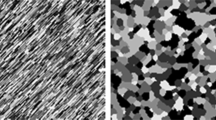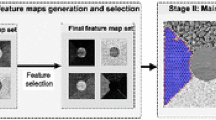Abstract
Inspired by an intuitive analogy that exists between the gray level textures and the miscibility in the multiphase fluids, the aura concept was developed from set theory tools in order to modeling the texture image. The gray level aura matrix (GLAM) has been then proposed to generalize the gray level cooccurrence matrix (GLCM) which remains very popular in the texture analysis. The GLAM indicates how much each gray level is present in the neighborhood of each other gray level. The neighborhood is defined by a structuring element as one used in mathematical morphology. The GLAM is mainly used and studied in synthesis and classification of textures framework but very few works are devoted to the segmentation. The aim of this paper is to exploit the GLAM for the segmentation of textured images. Experiments results over synthetic and real images show the efficiency of the GLAM. The influence of the shape and the size of the structuring element on the segmentation results are also studied.










Similar content being viewed by others
References
Tuceryan, M., & Jain, A. K. (1998). Texture analysis. In C. H. Chen, L. F. Pau, & P. S. P. Wang (Eds.), Chapter 2.1.The handbook of pattern recognition and computer vision (pp. 207–248). Singapore: World Scientific Publishing Co.
Djeddi, M., Ouahabi, A., Batatia, H., Basarab, A., & Kouamé, D. (2010). Discrete wavelet for multifractal texture classification: application to medical ultrasound imaging. In IEEE International Conference on Image Processing, Hong Kong.
Wang, Z., Guerriero, A., & De Sario, M. (1996). Comparison of several approaches for the segmentation of texture images. Pattern Recognition Letters, 17, 509–521.
Comaniciu, D., & Meer, P. (2002). Mean Shift: a robust approach toward feature space analysis. IEEE Transactions on Pattern Analysis and Machine Intelligence, 24(5), 1–18.
Cariou, K., & Chehdi, K. (2008). Unsupervised texture segmentation/classification using 2-D autoregressive modeling and the stochastic expectation-maximization algorithm. Pattern Recognition Letters, 29, 905–917.
Kato, Z., & Pong, T.-C. (2006). A Markov random field image segmentation model for color textured images. Image and Vision Computing, 24, 1103–1114.
Haralick, R. M., Shanmugam, K., & Dinstein, I. H. (1973). Textural features for image classification. IEEE Transactions on Systems Man and Cybernitics, 3(6), 610–621.
Manjunath, B. S., & Chellappa, R. (1991). Unsupervised texture segmentation using Markov random field models. IEEE Transactions on Pattern Analysis and Machine Intelligence, 13, 478–482.
Ojala, T., & Pietikainen, M. (1996). A comparative study of texture measures with classification based on feature distributions. Pattern Recognition, 29(1), 51–59.
Jain, A. K., & Farrokhnia, F. (1991). Unsupervised texture segmentation using Gabor filters. Pattern Recognition, 24, 1167–1186.
Porter, R., & Canagarajah, N. (1996). A robust automatic clustering scheme for image segmentation using wavelets. IEEE Transaction on Image Processing, 5, 662–665.
Keller, J. M., & Crownover, R. M. (1989). Texture description and segmentation through fractal geometry. CVGIP: Graphical Models and Image Processing, 45, 150–166.
Buf, J. D., Kardan, M., & Spann, M. (1990). Texture feature performance for image segmentation. Pattern Recognition, 23(3/4), 291–309.
Vince, D. G., Dixon, K. J., Cothren, R. M., & Cornhill, J. F. (2000). Comparison of texture analysis methods for the characterization of coronary plaques in intravascular ultrasound images. Computerized Medical Imaging and Graphics, 24, 221–229.
Christodoulou, C. I., Pattichis, C. S., Pantziaris, M., & Nicolaides, A. (2003). Texture-based classification of atherosclerotic Carotid Plaques. IEEE Transactions on Medical Imaging, 22(7), 902–912.
Christodoulou, C. I., Michaelides, S. C., & Pattichis, C. S. (2003). Multifeature texture analysis for the classification of clouds in satellite imagery. IEEE Transactions on Geoscience and Remote Sensing, 41(11), 2662–2668.
Elfadel, I.-M., & Picard, R.-W. (1994). Gibbs random fields, co-occurrences, and texture modeling. IEEE Transaction on Pattern Analysis and Machine Intelligence, 16(1), 24–37.
Qin, X., & Yang, Y.-H. (2004). Similarity measure and learning with gray level aura matrices (GLAM) for texture image retrieval. IEEE Computer Vision and Pattern Recognition, 1, 326–333.
Qin, X., & Yang, Y.-H. (2005). Basic gray level aura matrices: theory and its application to texture synthesis. In IEEE International Conference on Computer Vision (pp. 128–135).
Qin, X., & Yang, Y.-H. (2007). Aura 3D textures. IEEE Transaction on Visualization and Computer Graphics, 13(2), 379–389.
Syrjäsuo, M.T., Donova, E.F., Qin, X., & Yang, Y.-H. (2006). Automatic classification of auroral images in substorm studies. In International Conference on Substorms (vol. 8, pp. 309–313).
Liao, S., & Chung, A. C. S. (2007). Texture classification by using advanced local binary patterns and spatial distribution of dominant patterns. International Conference on Acoustics, Speech and Signal Processing, 1, 1221–1224.
Qin, X., & Yang, Y.-H. (2006). Texture image classification using basic gray level aura matrices. http://citeseerx.ist.psu.edu .
Qin, X., & Yang, Y.-H. (2005). Representing texture images using asymmetric gray level aura matrices. http://citeseerx.ist.psu.edu .
Wiesmüller, S., & Chandy, D. A. (2010). Content based mammogram retrieval using gray level matrix. In Proceedings of the International Joint Journal Conference on Engineering and Technology (IJJCET 2010) (pp. 217–221).
Wang, Y., Gao, X., Fu, R., & Jian, Y. (2010). Dayside corona aurora classification based on X-gray level aura matrices. In Proceedings of the ACM International Conference on Image and Video Retrieval (pp. 282–287).
Brodatz, P. (1956). Texture: a photograph album for artists and designs. New York: Dover.
Author information
Authors and Affiliations
Corresponding author
Rights and permissions
About this article
Cite this article
Haliche, Z., Hammouche, K. The gray level aura matrices for textured image segmentation. Analog Integr Circ Sig Process 69, 29–38 (2011). https://doi.org/10.1007/s10470-011-9630-9
Received:
Revised:
Accepted:
Published:
Issue Date:
DOI: https://doi.org/10.1007/s10470-011-9630-9




